An Agenda-Setting Account for Psychological Typhoon Eye Effect on Responses to the Outbreak of COVID-19 in Wuhan
Abstract
1. Introduction
2. Materials and Methods
2.1. Participants
2.1.1. Predictor Variables: Distances to Wuhan
2.1.2. Outcome Variables: Risk Perception of COVID-19 in Wuhan
2.1.3. Mediator Variables: Risk Information Proportion
2.1.4. Control Variables
2.2. Statistical Analyses
2.2.1. Data Preprocessing
2.2.2. Construct Validity and Reliability
2.2.3. Analyses
3. Results
3.1. Construct Validity and Reliability
3.2. Correlation
3.3. Effect of Distances on the Risk Perception of COVID-19 in Wuhan
3.4. Effect of Distances on the Risk Perception of COVID-19 in Wuhan through Risk Information Proportion
4. Discussion
5. Conclusions
Author Contributions
Funding
Institutional Review Board Statement
Informed Consent Statement
Data Availability Statement
Acknowledgments
Conflicts of Interest
References
- Slovic, P.; Peters, E. Risk Perception and Affect. Curr. Dir. Psychol. Sci. 2006, 15, 322–325. [Google Scholar] [CrossRef]
- Slovic, P. Perception of risk. Science 1987, 236, 280–285. [Google Scholar] [CrossRef] [PubMed]
- Li, S.; Liu, H.; Zheng, R.; Bai, X.-W.; Ren, X.-P.; Li, J.-Z.; Rao, L.-L.; Wang, Z.-J. Psychological typhoon eye in the 2008 Wenchuan earthquake of May 12. Sci. Tech. Rev. 2009, 27, 87–89. [Google Scholar]
- Li, S.; Rao, L.-L.; Ren, X.-P.; Bai, X.-W.; Zheng, R.; Li, J.-Z.; Wang, Z.-J.; Liu, H. Psychological Typhoon Eye in the 2008 Wenchuan Earthquake. PLoS ONE 2009, 4, e4964. [Google Scholar] [CrossRef] [PubMed]
- Chen, Y.; Feng, J.; Chen, A.; Lee, J.E.; An, L. Risk perception of COVID-19: A comparative analysis of China and South Korea. Int. J. Disaster Risk Reduct. 2021, 61, 102373. [Google Scholar] [CrossRef]
- Li, S.; Rao, L.-L.; Bai, X.-W.; Zheng, R.; Ren, X.-P.; Li, J.-Z.; Wang, Z.-J.; Liu, H.; Zhang, K. Progression of the “Psychological Typhoon Eye” and variations since the Wenchuan earthquake. PLoS ONE 2010, 5, e9727. [Google Scholar] [CrossRef]
- Zheng, R.; Rao, L.-L.; Zheng, X.-L.; Cai, C.; Wei, Z.-H.; Xuan, Y.-H.; Li, S. The more involved in lead-zinc mining risk the less frightened: A psychological typhoon eye perspective. J. Environ. Psychol. 2015, 44, 126–134. [Google Scholar] [CrossRef]
- Li, S.; Wang, Z.-J.; Rao, L.-L.; Zheng, R.; Ren, X.-P.; Li, J.-Z.; Liu, H.; Bi, Y.-L.; Wang, F.; Bai, X.-W. How long is long enough: Public worry about the devastated students’ academic career since Wenchuan Earthquake. Psychologia 2011, 54, 80–86. [Google Scholar] [CrossRef]
- Wei, Z.H.; Tao, R.; Liu, H.; Li, S. ‘Freedom from fear and want’ and our psychological response to environmental changes. J. Pac. Rim Psychol. 2017, 11, e10. [Google Scholar] [CrossRef]
- Bonanno, G.A.; Brewin, C.R.; Kaniasty, K.; Greca, A.M.L. Weighing the costs of disaster: Consequences, risks, and resilience in individuals, families, and communities. Psychol. Sci. Public Interest 2010, 11, 1–49. [Google Scholar] [CrossRef] [PubMed]
- Bartels, S.A.; VanRooyen, M.J. Medical complications associated with earthquakes. Lancet 2012, 379, 748–757. [Google Scholar] [CrossRef]
- Kun, P.; Chen, X.; Han, S.; Gong, X.; Chen, M.; Zhang, W.; Yao, L. Prevalence of post-traumatic stress disorder in Sichuan Province, China after the 2008 Wenchuan earthquake. Public Health 2009, 123, 703–707. [Google Scholar] [CrossRef] [PubMed]
- Li, S.; Li, J.-L.; Yang, S.-W.; Wu, X.-J.; Chen, J.-F.; Ding, Y.; Lin, Y.-X.; Bai, X.-W.; Luan, S.-H.; Zheng, R. The psychological typhoon eye effect in responses to terrorism. J. Pac. Rim Psychol. 2020, 14, e21. [Google Scholar] [CrossRef]
- Xie, X.-F.; Zheng, R.; Xie, D.-M.; Wang, H. Analysis on psychological panic phenomenon of SARS. Acta Sci. Nat. Univ. Pekin. 2005, 41, 628–639. [Google Scholar]
- Hoven, C.W.; Duarte, C.S.; Lucas, C.P.; Wu, P.; Mandell, D.J.; Goodwin, R.D.; Cohen, M.; Balaban, V.; Woodruff, B.A.; Bin, F.; et al. Psychopathology Among New York City Public School Children 6 Months After September 11. Arch. Gen. Psychiatry 2005, 62, 545–552. [Google Scholar] [CrossRef] [PubMed]
- Wang, X.; Gao, L.; Shinfuku, N.; Zhang, H.; Zhao, C.; Shen, Y. Longitudinal Study of Earthquake-Related PTSD in a Randomly Selected Community Sample in North China. Am. J. Psychiatry 2000, 157, 1260–1266. [Google Scholar] [CrossRef]
- Wang, G.; Zhang, Y.; Xie, S.; Wang, P.; Lei, G.; Bian, Y.; Huang, F.; Zhang, J.; Cao, X.; Luo, N.; et al. Psychological Typhoon Eye Effect During the COVID-19 Outbreak. Front. Public Health 2020, 8, 550051. [Google Scholar] [CrossRef]
- Wen, F.-F.; Ma, S.-H.; Ye, H.-X.; Qi, Y.; Zuo, B. “Psychological Typhoon Eye Effect” and “Ripple Effect”: Double perspective test of risk perception and anxiety characteristics of people in different COVID-19 severity regions. Acta Psychol. Sin. 2020, 52, 1–18. [Google Scholar] [CrossRef]
- Kahneman, D.; Krueger, A.B.; Schkade, D.; Schwarz, N.; Stone, A.A. Would You Be Happier If You Were Richer? A Focusing Illusion. Science 2006, 312, 1908–1910. [Google Scholar] [CrossRef] [PubMed]
- McCombs, M.E.; Shaw, D.L. The Agenda-Setting Function of Mass Media. Public Opin. Q. 1972, 36, 176–187. [Google Scholar] [CrossRef]
- Scheufele, D.A.; Tewksbury, D. Framing, Agenda Setting, and Priming: The Evolution of Three Media Effects Models. J. Commun. 2007, 57, 9–20. [Google Scholar] [CrossRef]
- Schkade, D.A.; Kahneman, D. Does Living in California Make People Happy? A Focusing Illusion in Judgments of Life Satisfaction. Psychol. Sci. 1998, 9, 340–346. [Google Scholar] [CrossRef]
- Schwertman, N.C.; Owens, M.A.; Adnan, R. A simple more general boxplot method for identifying outliers. Comput. Stat. Data Anal. 2004, 47, 165–174. [Google Scholar] [CrossRef]
- Tukey, J.W. Exploratory Data Analysis; Addison-Wesley: Reading, MA, USA, 1977. [Google Scholar]
- Cronbach, L.J. Coefficient alpha and the internal structure of tests. Psychometrika 1951, 16, 297–334. [Google Scholar] [CrossRef]
- McDonald, R.P. The theoretical foundations of principal factor analysis, canonical factor analysis, and alpha factor analysis. Br. J. Math. Stat. Psychol. 1970, 23, 1–21. [Google Scholar] [CrossRef]
- Velicer, W.F.; Eaton, C.A.; Fava, J.L. Construct explication through factor or component analysis. A review and evaluation of alternative procedures for determining the number of factors or components. In Problems and Solutions in Human Assessment: Honoring Douglas N. Jackson at Seventy, 2nd ed.; Goffin, R., Helmes, E., Eds.; Springer Science & Business Media: Totowa, NJ, USA, 2000; pp. 41–71. [Google Scholar]
- Hair, J.F.; Black, W.C.; Babin, B.J.; Anderson, R.E.; Tatham, R.L. Multivariate Data Analysis, 7th ed.; Prentice Hall: Upper Saddle River, NJ, USA, 2009. [Google Scholar]
- Hayes, A.F. Introduction to Mediation, Moderation, and Conditional Process Analysis: A Regression-Based Approach; Guilford Publications: New York, NY, USA, 2017. [Google Scholar]
- Preacher, K.J.; Hayes, A.F. Asymptotic and Resampling Strategies for Assessing and Comparing Indirect Effects in Multiple Mediator Models. Behav. Res. Methods 2008, 40, 879–891. [Google Scholar] [CrossRef]
- Okeke, C.U.; Armour, A. Post-landfill siting perceptions of nearby residents: A case study of Halton landfill. Appl. Geogr. 2000, 20, 137–154. [Google Scholar] [CrossRef]
- Xie, J.Q.; Xie, X.F.; Gan, Y.Q. Psychological typhoon eye effect in the Wenchuan earthquake. Acta Scicentiarum Nat. Univ. Pekinesis 2011, 47, 944–952. [Google Scholar]
- Xu, M.X.; Zheng, R.; Rao, L.L.; Kuang, Y.; Yang, S.W.; Ding, Y.; Li, J.; Li, S. Proposals for coping with “Psychological Typhoon Eye” effect detected in COVID-19. J. Chin. Acad. Sci. 2020, 35, 273–282. [Google Scholar]
- Festinger, L. A Theory of Cognitive Dissonance; Stanford University Press: Stanford, CA, USA, 1957. [Google Scholar]
- Henderson, A.S.; Montgomery, I.M.; Williams, C.L. Psychological immunisation: A Proposal for Preventive Psychiatry. Lancet 1972, 299, 1111–1113. [Google Scholar] [CrossRef] [PubMed]
- Van Leuven, S.; Deprez, A. ‘To follow or not to follow?’: How Belgian health journalists use Twitter to monitor potential sources. J. Appl. J. Media Stud. 2017, 6, 545–566. [Google Scholar] [CrossRef]
- Jiang, C.-M.; Zheng, R.; Zhou, Y.; Liang, Z.-Y.; Rao, L.-L.; Sun, Y.; Tan, C.; Chen, X.-P.; Tian, Z.-Q.; Bai, Y.-Q.; et al. Effect of 45-day simulated microgravity on the evaluation of orally reported emergencies. Ergonomics 2013, 56, 1225–1231. [Google Scholar] [CrossRef] [PubMed]
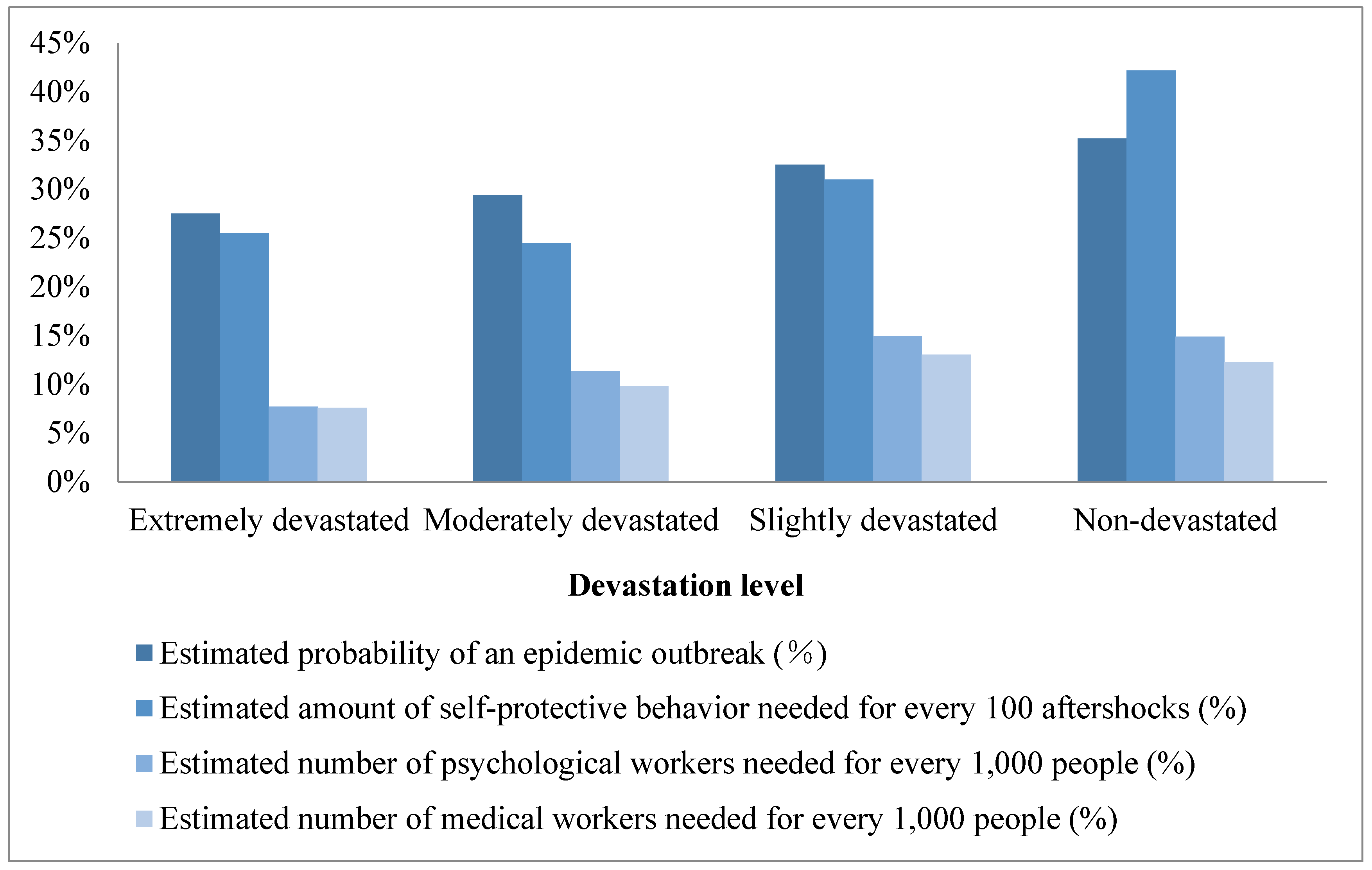
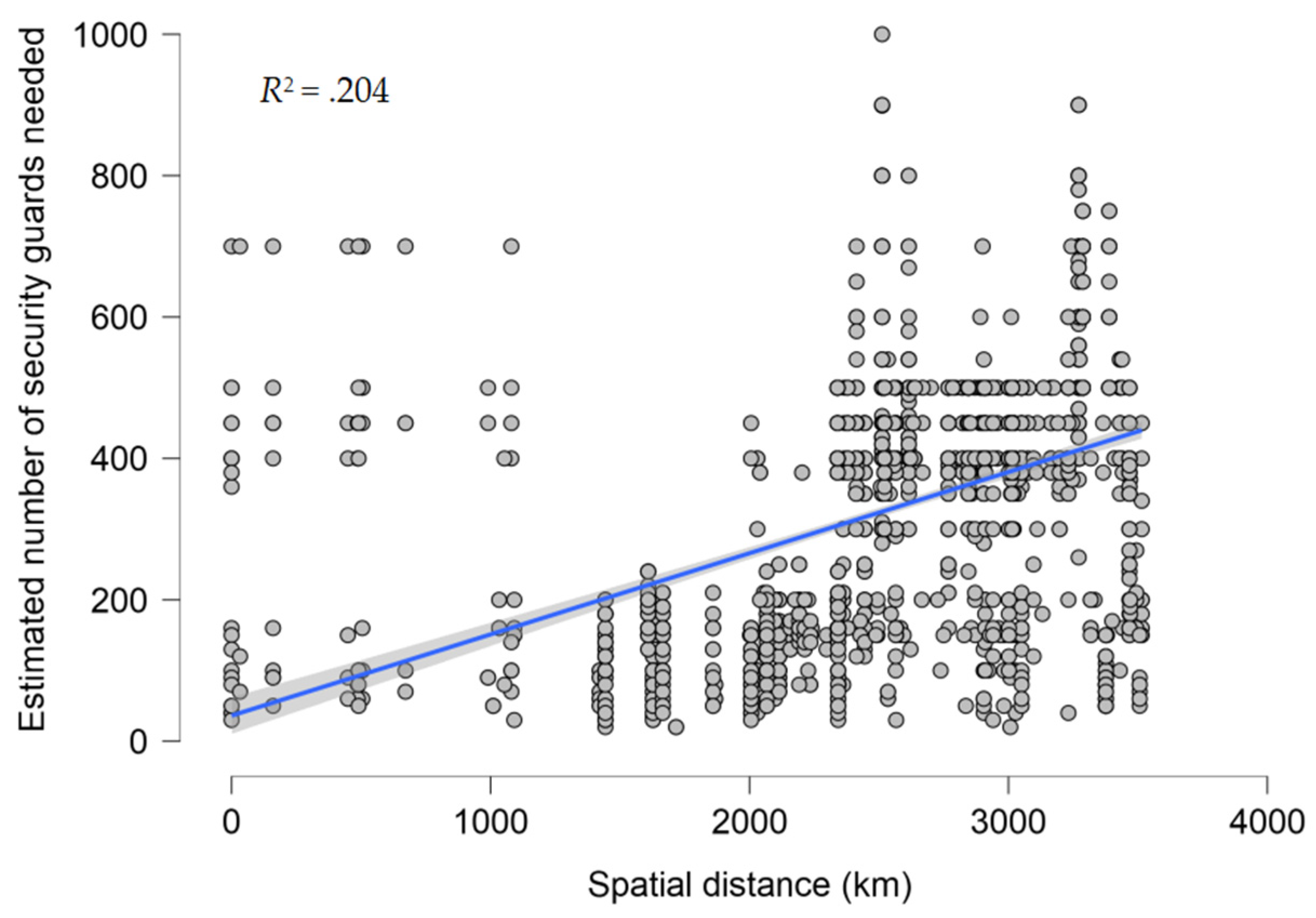

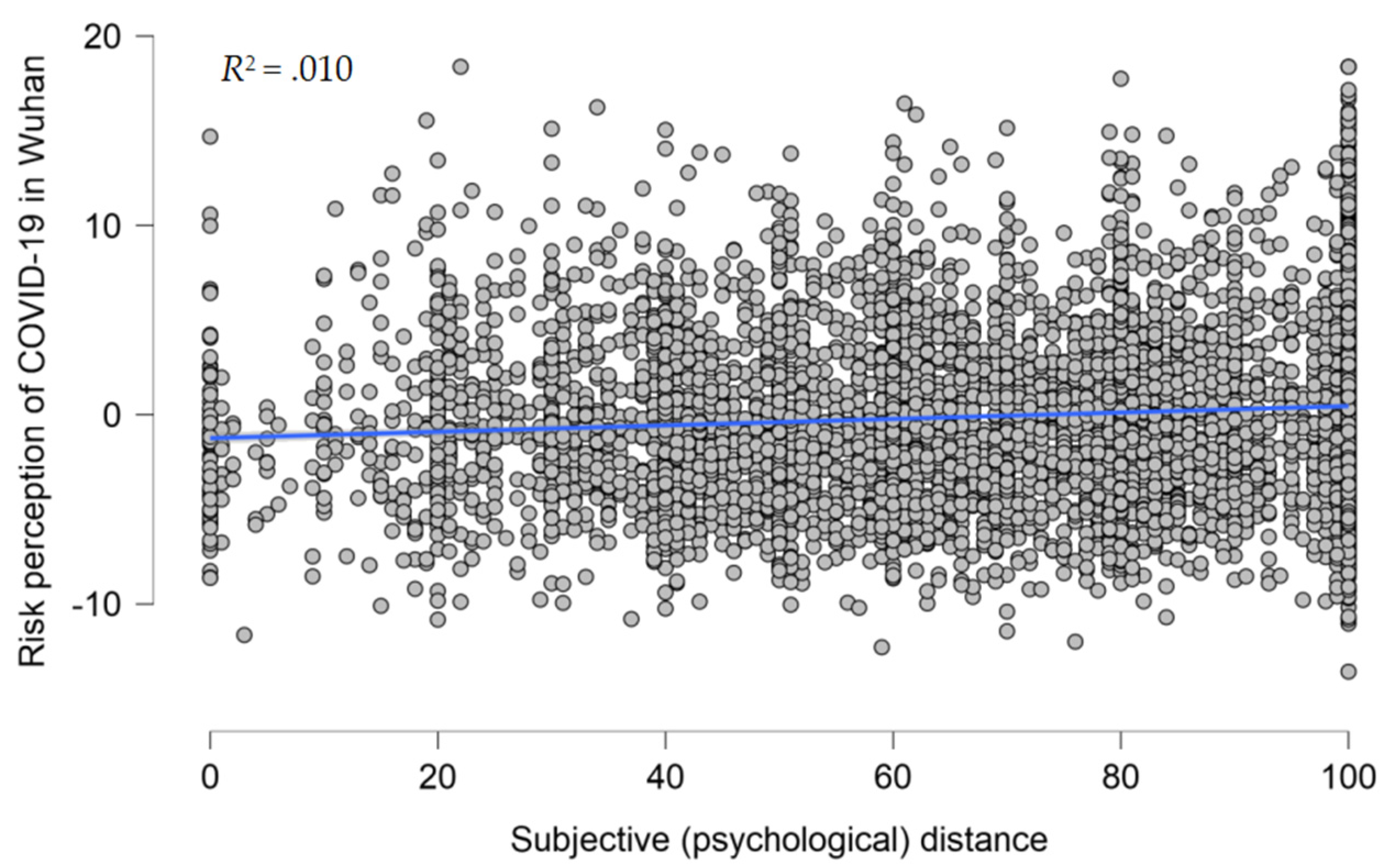
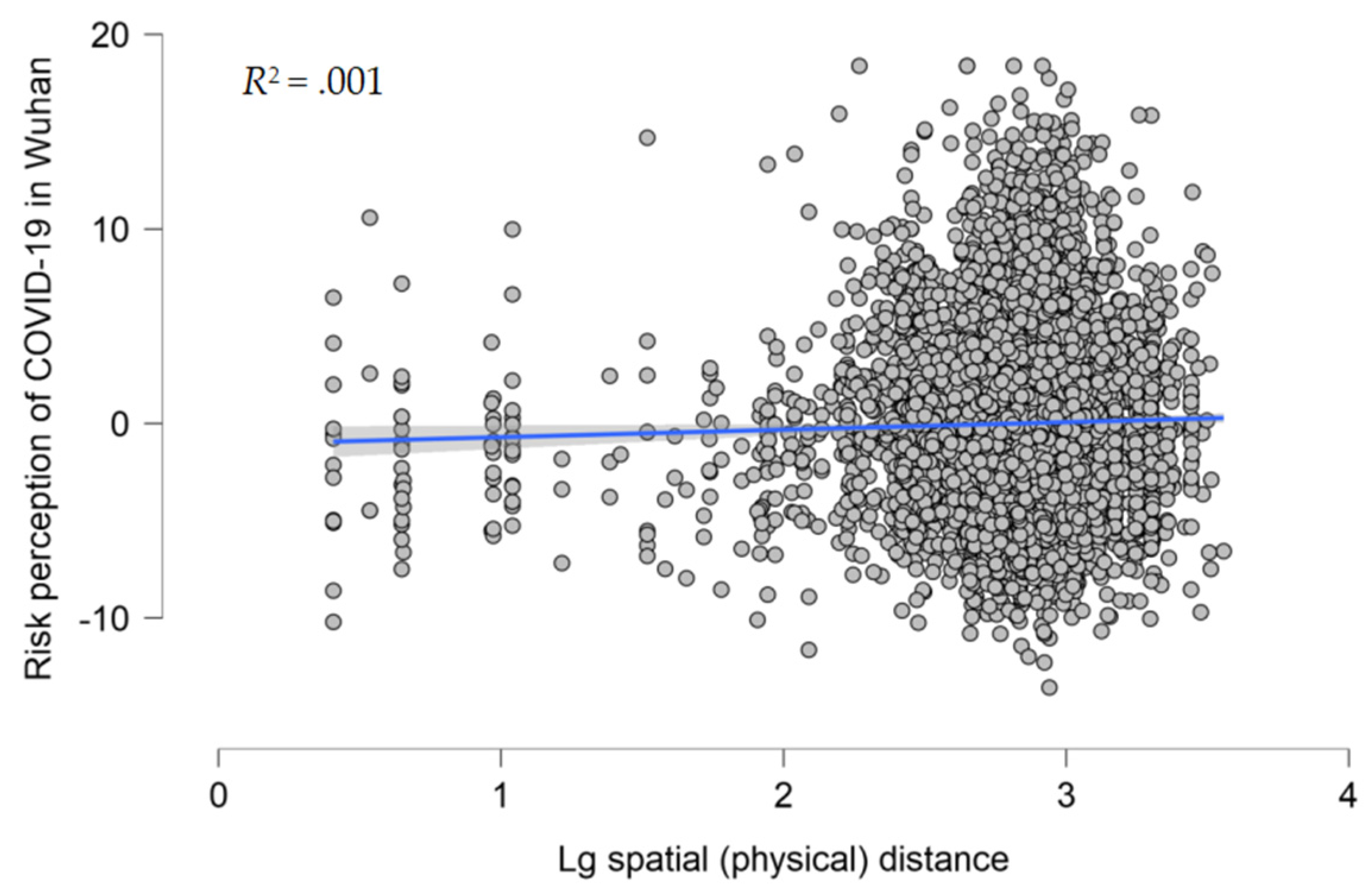
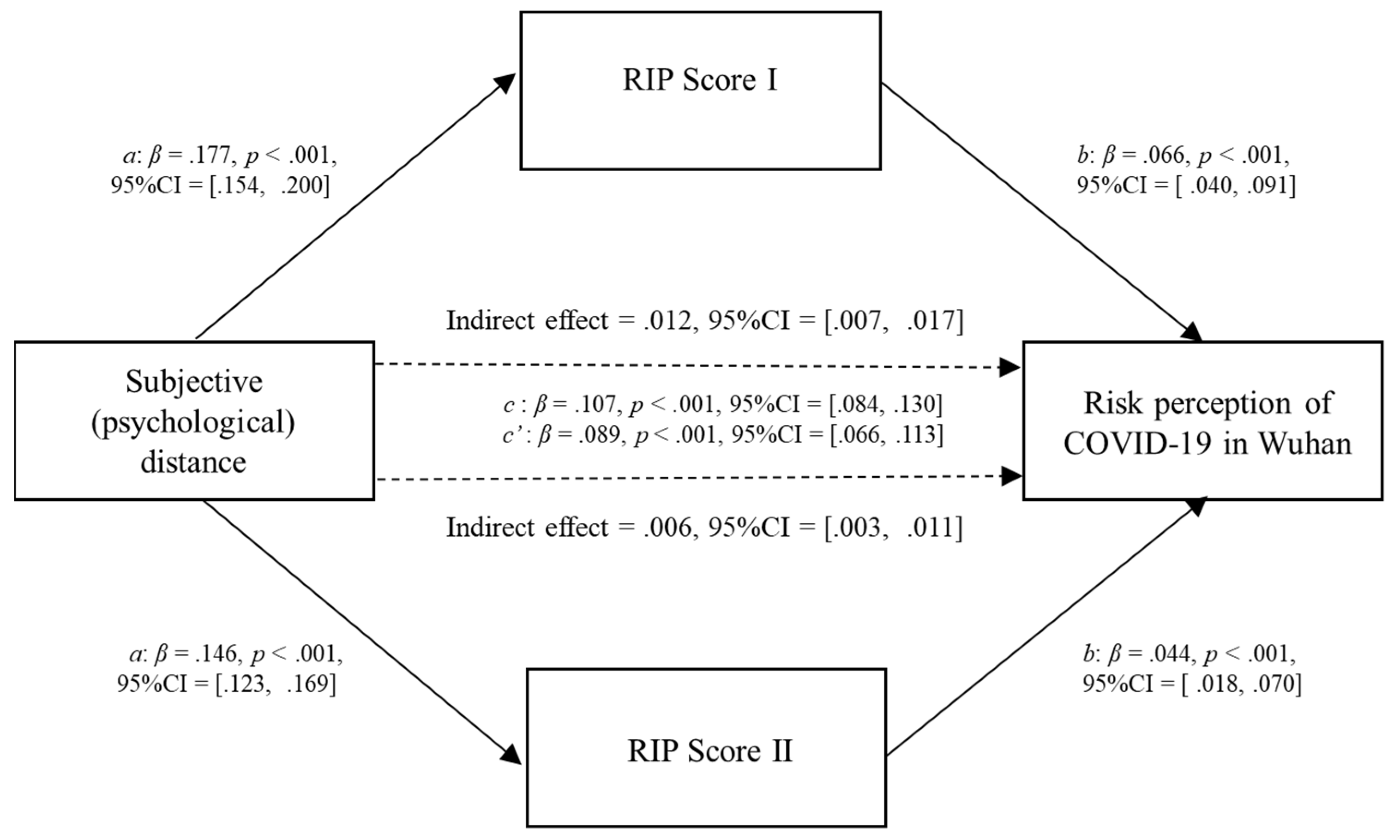
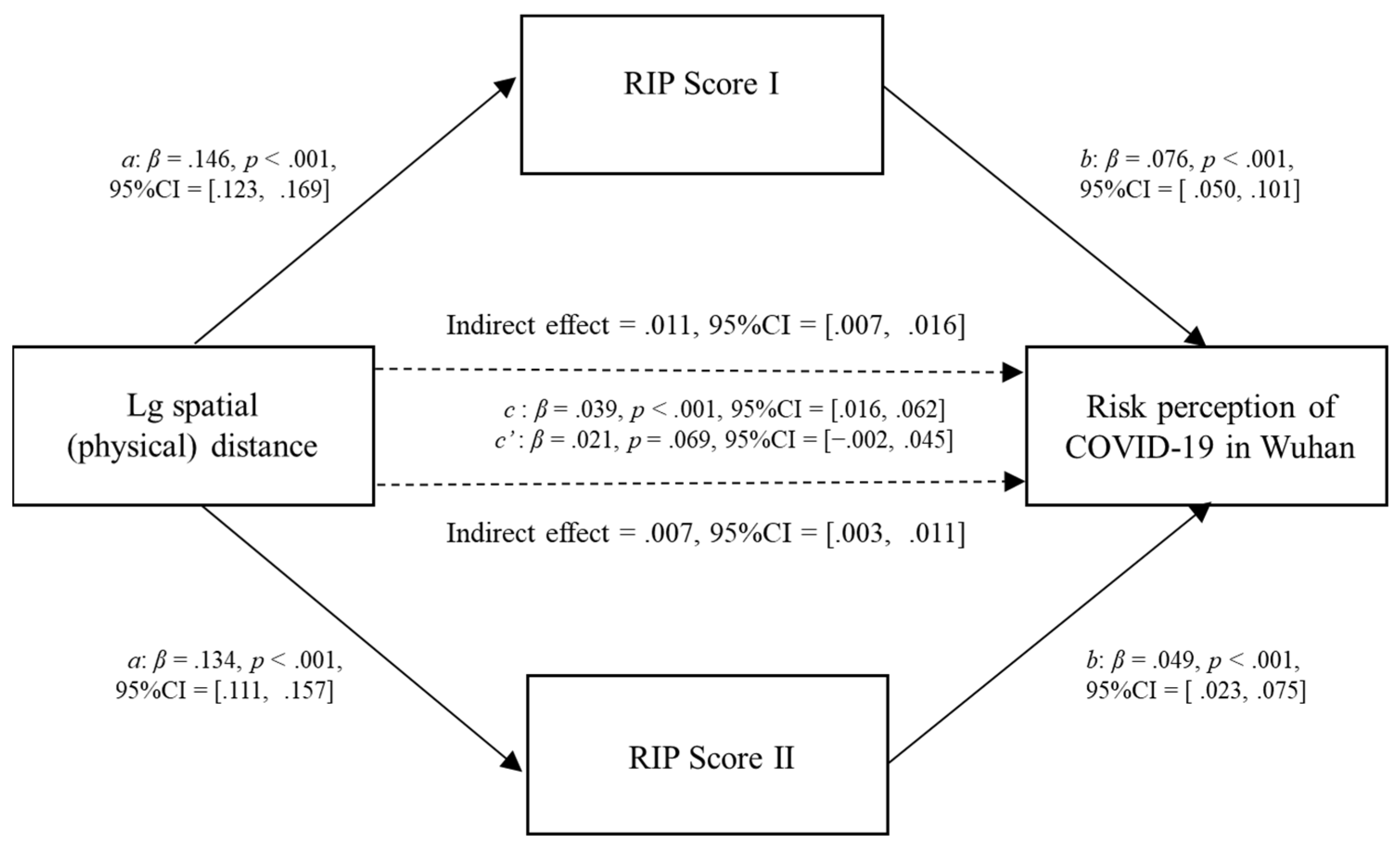
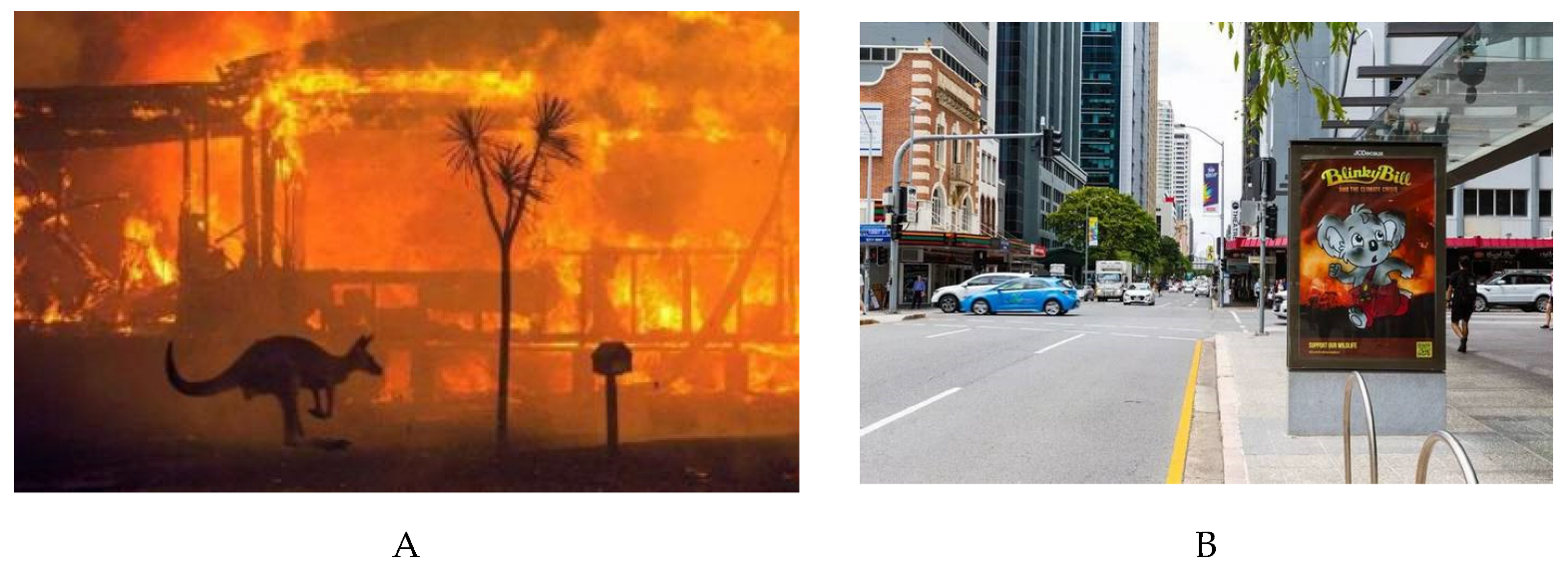
| . | Percentage | Percentage | |||
|---|---|---|---|---|---|
| Gender | Male | 43.5 | Age | Less than 17 | 2.7 |
| Female | 56.5 | 18–20 | 13.9 | ||
| Identity | 1 | 68.3 | 21–30 | 45.6 | |
| 2 | 27.3 | 31–40 | 25.0 | ||
| 3 | 2.3 | 41–50 | 9.2 | ||
| 4 | 0.3 | 51–80 | 3.4 | ||
| 5 | 0.2 | 81 and above | 0.2 | ||
| 6 | 1.7 |
| Item | Description | Factor 1 (Personal Prevention) | Factor 2 (Healthcare) | Factor 3 (Environmental Isolation) | Factor 4 (Interpersonal Prevention) |
|---|---|---|---|---|---|
| 13 | Estimated number of cleaning frequently touched surfaces | .842 | |||
| 12 | Estimated body temperature measurement | .766 | |||
| 14 | Estimated number of clothing changes | .685 | |||
| 1 | Estimated number of medical doctors needed for every 1000 residents in Wuhan | .786 | |||
| 2 | Estimated number of psychological workers needed for every 1000 residents in Wuhan | .781 | |||
| 10 | Estimated days to abide by the quarantine rules | .587 | |||
| 11 | Estimated days of delaying school reopening | .585 | |||
| 7 | Estimated times of hand shaking | .572 | |||
| 5 | Estimated number of social/family gatherings | .559 | |||
| Proportion var. (%) | 19.939 | 13.738 | 7.798 | 7.267 | |
| Cumulative (%) of variance explained | 19.939 | 33.677 | 41.475 | 48.742 | |
| Mean | SD | 1 | 2 | 3 | 4 | 5 | 6 | 7 | 8 | 9 | 10 | 11 | |
|---|---|---|---|---|---|---|---|---|---|---|---|---|---|
| 1 Gender | NA | NA | 1 | ||||||||||
| 2 Age | 29.712 | 9.234 | .156 *** | 1 | |||||||||
| 3 Identity | NA | NA | −.004 | −.026 * | 1 | ||||||||
| 4 Importance | 60.262 | 29.766 | −.047 *** | .010 | .053 *** | 1 | |||||||
| 5 Closeness | 52.870 | 31.547 | −.031 ** | .055 *** | .112 *** | .609 *** | 1 | ||||||
| 6 Time exposed to news about COVID-19 | 4.362 | 1.317 | −.001 | .124 *** | .074 *** | .089 *** | .124 *** | 1 | |||||
| 7 Subjective (psychological) distance | 73.227 | 25.777 | .061 *** | .146 *** | −.145 *** | −.001 | −.074 *** | −.016 | 1 | ||||
| 8 Lg spatial (physical) distance | 2.828 | 0.316 | −.012 | .060 *** | −.129 *** | −.093 *** | −.128 *** | −.026 * | .511 *** | 1 | |||
| 9 RIP Score I | 0.804 | 0.125 | −.031 ** | .061 *** | −.129 *** | −.042 *** | −.071 *** | −.016 | .197 *** | .169 *** | 1 | ||
| 10 RIP Score II | 8.063 | 1.353 | −.016 | .094 *** | −.133 *** | −.061 *** | −.097 *** | −.001 | .175 *** | .163 *** | .480 *** | 1 | |
| 11 Risk perception of COVID-19 in Wuhan | 0.000 | 4.473 | −.100 *** | −.028 * | −.023 * | .156 *** | .086 *** | .099 *** | .098 *** | .027* | .098 *** | .080 *** | 1 |
| Variable | Model 1 | Model 2 | ||||
|---|---|---|---|---|---|---|
| B | SE | β | B | SE | β | |
| Step 1 | ||||||
| Gender | −0.815 *** | 0.105 | −.090 | −0.852 *** | 0.105 | −.094 |
| Age | −0.008 | 0.006 | −.016 | −0.015 ** | 0.006 | −.031 |
| Identity | −0.303 ** | 0.112 | −.031 | −0.167 | 0.112 | −.017 |
| Importance | 0.024 *** | 0.002 | .159 | 0.023 *** | 0.002 | .151 |
| Closeness | −0.001 | 0.002 | −.009 | 0.000 | 0.002. | .002 |
| Step 2 | ||||||
| Subjective (psychological) distance | 0.018 *** | 002 | .106 | |||
| F value | 51.562 *** | 56.914 *** | ||||
| R2 | .034 | .045 | ||||
| Adj. R2 | .034 | .044 | ||||
| △ R 2 | .011 *** | |||||
| Variable | Model 1 | Model 2 | ||||
|---|---|---|---|---|---|---|
| B | SE | β | B | SE | β | |
| Step 1 | ||||||
| Gender | −0.816 *** | 0.105 | −.090 | −0.806 *** | 0.105 | −.089 |
| Age | −0.008 | 0.006 | −.016 | −0.009 | 0.006 | −.018 |
| Identity | −0.303 ** | 0.112 | −.031 | −0.262 * | 0.112 | −.027 |
| Importance | 0.024 *** | 0.002 | .159 | 0.024 *** | 0.002 | .160 |
| Closeness | −0.001 | 0.002 | −.009 | −0.001 | 0.002 | −.005 |
| Step 2 | ||||||
| Spatial (physical) distance | 0.536 ** | 0.166 | .038 | |||
| F value | 51.572 *** | 44.781 *** | ||||
| R2 | .034 | .036 | ||||
| Adj. R2 | .034 | .035 | ||||
| △ R2 | .001 ** | |||||
| Mediator | Outcome Variable | ||||||||
|---|---|---|---|---|---|---|---|---|---|
| RIP Score I | RIP Score II | Risk Perception of COVID-19 in Wuhan | |||||||
| B | SE | β | B | SE | β | B | SE | β | |
| Subjective (psychological) distance | 0.001 *** | 0.000 | .177 | 0.008 *** | 0.001 | .146 | 0.016 *** | 0.002 | .089 |
| RIP Score I | 2.352 *** | 0.469 | .066 | ||||||
| RIP Score II | 0.145 *** | 0.043 | .044 | ||||||
| F | 60.810 *** | 60.418 *** | 53.400 *** | ||||||
| R2 | .055 | .055 | .062 | ||||||
| Mediator | Outcome Variable | ||||||||
|---|---|---|---|---|---|---|---|---|---|
| RIP Score I | RIP Score II | Risk Perception of COVID-19 in Wuhan | |||||||
| B | SE | β | B | SE | β | B | SE | β | |
| Spatial (physical) distance | 0.058 *** | 0.005 | .146 | 0.573 *** | 0.050 | .134 | 0.302 | 0.166 | .021 |
| RIP Score I | 2.706 *** | 0.469 | .076 | ||||||
| RIP Score II | 0.163 *** | 0.044 | .049 | ||||||
| F | 50.336 *** | 57.182 *** | 47.128 *** | ||||||
| R2 | .046 | .052 | .055 | ||||||
Disclaimer/Publisher’s Note: The statements, opinions and data contained in all publications are solely those of the individual author(s) and contributor(s) and not of MDPI and/or the editor(s). MDPI and/or the editor(s) disclaim responsibility for any injury to people or property resulting from any ideas, methods, instructions or products referred to in the content. |
© 2023 by the authors. Licensee MDPI, Basel, Switzerland. This article is an open access article distributed under the terms and conditions of the Creative Commons Attribution (CC BY) license (https://creativecommons.org/licenses/by/4.0/).
Share and Cite
Yang, S.-W.; Xu, M.-X.; Kuang, Y.; Ding, Y.; Lin, Y.-X.; Wang, F.; Rao, L.-L.; Zheng, R.; Li, S. An Agenda-Setting Account for Psychological Typhoon Eye Effect on Responses to the Outbreak of COVID-19 in Wuhan. Int. J. Environ. Res. Public Health 2023, 20, 4350. https://doi.org/10.3390/ijerph20054350
Yang S-W, Xu M-X, Kuang Y, Ding Y, Lin Y-X, Wang F, Rao L-L, Zheng R, Li S. An Agenda-Setting Account for Psychological Typhoon Eye Effect on Responses to the Outbreak of COVID-19 in Wuhan. International Journal of Environmental Research and Public Health. 2023; 20(5):4350. https://doi.org/10.3390/ijerph20054350
Chicago/Turabian StyleYang, Shu-Wen, Ming-Xing Xu, Yi Kuang, Yang Ding, Yu-Xin Lin, Fei Wang, Li-Lin Rao, Rui Zheng, and Shu Li. 2023. "An Agenda-Setting Account for Psychological Typhoon Eye Effect on Responses to the Outbreak of COVID-19 in Wuhan" International Journal of Environmental Research and Public Health 20, no. 5: 4350. https://doi.org/10.3390/ijerph20054350
APA StyleYang, S.-W., Xu, M.-X., Kuang, Y., Ding, Y., Lin, Y.-X., Wang, F., Rao, L.-L., Zheng, R., & Li, S. (2023). An Agenda-Setting Account for Psychological Typhoon Eye Effect on Responses to the Outbreak of COVID-19 in Wuhan. International Journal of Environmental Research and Public Health, 20(5), 4350. https://doi.org/10.3390/ijerph20054350






